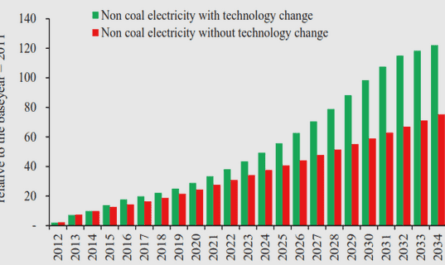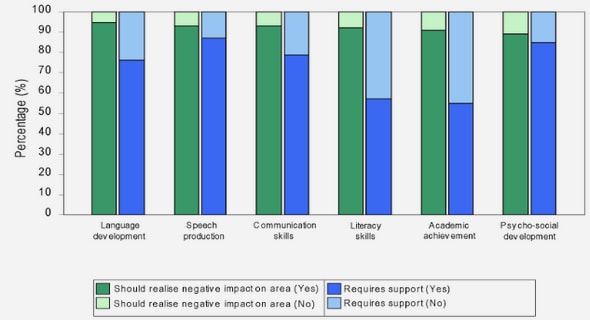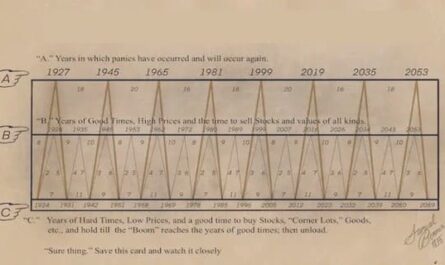Get Complete Project Material File(s) Now! »
Robustness Checks
We run a series of robustness checks investigating whether the observed migration patterns could be driven by mechanisms other than responses to changes in positively valued public goods.
A first concern is that changes in local public spending may not be valued by residents in themselves, but may be correlated with changes in housing supply determinants through EC . This would be the case if public good shocks were land improvements — new roads, pathways, etc. — of no intrinsic value but destined to welcome social housing units or private housing developments following changes in land use regulation. Residents would migrate towards municipalities experiencing positive housing supply shocks because of lower rents. More generally, if our subsidy shocks are correlated with shocks in the determinants of housing supply it may bias the interpretation of our estimates. As a test to alleviate this concern, we can look back at the rents results of Figure 1.9. A positive housing supply shock would have a negative effect on rents. Our results show the exact opposite suggesting that people indeed value local public goods beyond any correlated shift in the housing supply curve.
A second concern is that migration responses may entirely be driven by the inflow of public employees necessary to operate the new facilities or services financed by the subsidy shocks. Indeed, our model does not account for public employment. Public goods may be of little value in themselves, but workers may react to public labor demand shocks that would increase wages. It is not conceptually a problem as we could have modelled public good provision as taking public employment as input. The identification of the partial effect of public good supply would still be achieved in the GMM procedure provided that we separately instrument changes in local wages. We nevertheless assess the importance of this channel and show evidence that the public employment effect is marginal. We look at how the share of public employees in the population — crudely measured as public staff payroll divided by total local payroll — evolves around subsidy shocks. Combining this estimate with total population responses and the pre-shock shares of public employees, we conclude that observed behavioral responses coming from public employment only explain approximately 12% of total 20–65 population response (see derivations in appendix A.3).
Structural Estimation
This section carries out a GMM estimation of the model’s parameters. We derive moments conditions using expressions for changes in residential amenities introduced in Section 1.3. Section 1.5 makes the case for subsidy shocks as a valid instrument in this framework. We provide additional evidence that residential amenity changes are likely mean-independent of subsidy shocks and ground our GMM estimation strategy on these more stringent conditions.
Generalized Method of Moments
As mentioned, we structurally estimate the models’ parameters using a non-linear generalized method of moments. We ground our GMM estimation on moment conditions of the form where Z is an instrument uncorrelated with changes in unobserved residential amenities ln EA. Section 1.5 gives support to the following two moment conditions :
where Zj (resp. Zóa) is a variable of residuals obtained from regressing 2007, 2009 and 2010 subsidy shocks ln Sj (resp. ln Sóa) on a vector of flexible dummies for 1999 baseline char-acteristics and lagged shocks as in regression (1.21) (resp. (1.22)).
Section 1.5 provides evidence of the absence of pre-trends in the model’s endogenous vari-ables, which implies that the empirical counterparts of conditions (1.24) hold in pre-shock periods. To see why, notice that equations (1.19) and (1.20) express changes in residential amenities as a sum of linear functions of observables. Sufficient conditions for (1.24) to hold for pre-shock periods are then E ln j j = 0 and E ln Ya Za = 0 in pre-shock periods for all observables Y 1.19) and (1.20), which is precisely what Section 1.5 shows.
As is typically done in DiD frameworks, we make the assumption that this absence of correl-ation between subsidy shocks and amenity changes also holds for post-shock periods, which allows us to estimate model parameters with GMM.
In practice, the GMM procedure looks for the set of parameters that minimizes the em-pirical counterparts of our moment conditions, keeping the endogenous variables of the model at their observed values in the data. As such, the two moment conditions in (1.24) are not enough on their own to identify all the parameters of our model. Our GMM estimation relies on more moments conditions. In particular, we investigate whether more restrictive condi-tions of the form E ln EAjZ = 0 hold. It would similarly be supported by evidence that the empirical counterpart of E [ ln Y jZ] = 0 holds for all outcomes Y in pre-shock periods. The next section provides non-parametric evidence of such relationship between subsidy shock intensity and cumulative outcome changes.
Non-Parametric Evidence
We provide further evidence on the absence of pre-trends by looking at the non-parametric relationship between subsidy shocks on the one hand, and pre- or post-shock cumulative outcome changes on the other hand. We run kernel regressions where the dependent variable is alternatively ln Gj; 6; 2, ln Gj; 2;4, ln Nj; 6; 2 and ln Nj; 2;4. The explanatory variable is Zj; 1;0, i.e., the variable of residuals obtained from regressing 2007, 2009 and 2010 shocks ln Sj; 1;0 on the set of baseline controls and lagged shocks.23 Figure 1.10 presents The fitted values and confidence bands are computed from running kernel regressions of the dependent variable on these initial residuals and on 1000 additional samples of residuals. We generate synthetic residuals using the wild cluster bootstrap procedure proposed in Cameron et al. (2008). We assume that errors are correlated within clusters which we take to be counties. Each cluster randomly draws a +1= 1 coefficient with probability 0.5 and all residuals of a same cluster are multiplied by the same coefficient. These synthetic the results.
The dependent variable in Panel A (resp. in Panel C) is ln Gj; 6; 2 (resp. ln Nj; 6; 2). Panels A and C show again that the average relationship between subsidy shock and pre-shock outcome growth is close to zero. In addition, they offer evidence that municipality expected outcomes grow at the same rate as their MF geometric average conditional on shock intensity. In mathematical terms, this translates into E ln Y j; 6; 2jZj; 1;0 = 0 for Y 2 fG; Ng. This mean-independence property will be central to our GMM analysis.
Note: This Figure shows the outcomes of non-parametric regressions where the explanatory variable is the between-MF relative subsidy shock. All changes are relative to mean regional changes. Dependent and ex-planatory variables are first residualized with respect to bins of fixed 1999 characteristics and lagged shocks. Bias-corrected fitted values and 1% confidence band are computed based on 1; 000 bootstrap replications. along the distribution of shock intensity. Finally, Figure 1.12 similarly shows that housing prices ln ra evolve in a similar fashion in different cells of shock intensity in pre-shock peri-ods and that the price response is coming from the full range of shock values.
These graphs also show that changes in jurisdictions’ populations and rents are not ne-cessarily proportional to changes in local public goods. Our model supports these non-proportional responses. For example, jurisdictions’ proportional responses to changes in local public goods may differ because of heterogeneity in housing supply elasticity or pro-duction technology for the traded good. In addition, jurisdictions’ budget constraints intro-duce non-linearity in endogenous variables’ responses to subsidy shocks. Importantly, these non-proportional responses are precisely what enables us to add more moment conditions to (1.24).
Moment Conditions
The non-parametric evidence in Section 1.6.2 showed that subsidy shocks likely satisfy mean-independence conditions of the form E[ ln EjZ] = 0. These are more restrictive than the usual conditions of zero correlation between instrument and unobserved fundamentals E[ ln E Z] = 0. Indeed, with mean-independence of the unobserved fundamentals with respect to our original instrument Z, any function of Z may be used as an additional instrument (see Wooldridge 2010). We apply this property to a discrete number of indicator functions as in Ahlfeldt et al. (2015): we partition the empirical distribution of Z (or Zó) into subintervals of equal range. We define IWm (resp. IBm) the indicator function equal to one if Z (resp. Zó) belongs to the subinterval m of the partition of Z (resp. of Zó).
Table of contents :
1 This Town Ain’t Big Enough? Quantifying Public Good Spillovers
1.1 Introduction
1.2 Institutional Background
1.3 Theoretical Model
1.3.1 Preferences
1.3.2 Conditional Housing Demand
1.3.3 Demand for Jurisdictions
1.3.4 Housing Supply
1.3.5 Labor Demand
1.3.6 Public Good Supply
1.3.7 Equilibrium
1.3.8 Residential Amenities
1.4 Data
1.5 Reduced-Form Evidence
1.5.1 DiD Framework
1.5.2 Results
1.5.3 Robustness Checks
1.6 Structural Estimation
1.6.1 Generalized Method of Moments
1.6.2 Non-Parametric Evidence
1.6.3 Moment Conditions
1.6.4 Estimation Results
1.7 Welfare Implications
1.8 Conclusion
2 Optimal Spatial Policies with Public Goods and Unobserved Location Preferences
2.1 Introduction
2.2 Data
2.3 Stylized Facts on Public Good Agglomeration Economies
2.3.1 Raw Patterns
2.3.2 Descriptive Regressions
2.3.3 Preliminary Comments on Welfare
2.4 Economic Geography Model with Local Public Goods
2.4.1 Central Government
2.4.2 Demand for Cities
2.4.3 Demand for Private Goods
2.4.4 Supply and Ownership
2.4.5 Demand for Public Goods and Tax Competition
2.4.6 Equilibrium
2.5 Optimal Policies
2.5.1 Intuition in a Two-Region Example
2.5.2 Efficient Allocations
2.5.3 Optimal Transfers
2.5.4 An Efficiency Test
2.5.5 Efficiency of Observed Transfers
2.6 Equity and Density
2.6.1 Compensation and Responsibility
2.6.2 Revealed Social Preferences
2.7 Conclusion
3 The Deadweight Loss of Property Transaction Taxes
3.1 Introduction
3.2 Institutional Background and Data
3.2.1 French Administrative Geography
3.2.2 The French Stamp Duty
3.2.3 The 2014 Stamp Duty Reform
3.2.4 Data and Descriptive Evidence
3.3 Bunching
3.3.1 Bunching at the Time Notch
3.3.2 Bunching at the Border Notch
3.4 Extensive Responses
3.4.1 Treatment, Control and Spillovers
3.4.2 A Synthetic Control Approach
3.4.3 Average Effect on Number of Transactions
3.4.4 Average Effect on Prices and Quality
3.4.5 Statistical Inference
3.4.6 Public Spending
3.5 A Simple Search Model
3.5.1 Model
3.5.2 Welfare
3.6 Conclusion


